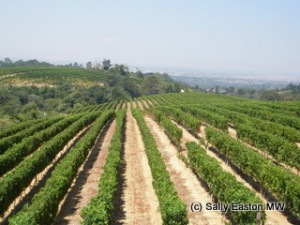High alcohol
A version of this article was first published in Food Development magazine, September 2006.
Awareness is gradually growing of how much alcohol is in a bottle of wine. It used to be that wine alcohol was an integral, seamless, unnoticed element of a wine’s overall flavour, but wine is becoming increasingly alcoholic, to the extent that ‘alcohol burn’ is becoming apparent. This kicks out of balance the equilibrium of a wine and can also interfere with that sacred food and wine matching territory.

One of the main trends over the last quarter century is to leave grapes on the vine longer, so they ripen more. This means sugars increase, tannins are fatter and fleshier, and it also means acidities are lower (as sugars increase in ripening grapes, acids decrease). With more sugar, and with more efficient yeast, alcohols have been rising, up to 2% in the last couple of decades. When Steve Kirkham, head sommelier, at The Don Restaurant was asked by one of his customers for a Bordeaux with just 12%, he could not find a single bottle in the restaurant’s cellar. The norm for Bordeaux used to be 11.5%.
The evidence is indisputable. Bordeaux’s Château Ausone has charted its alcohol from 12.5% in 1982 to 13.9% in 2002. In the last thirty years of the 20th century California wine rose from 12.5% to an even more heady 15% alcohol. And zinfandels are usually considerably higher than this.
Alongside these higher alcohols, the fruit can move out of a fresh, primary fruit spectrum, into the jammy, baked fruit, prune, and raisin spectrum. Combine this with lower acidity and greater tannin ripeness, and wines can start to taste a bit blousy, certainly alcoholic, up to 16+% in some instances, and often with this style, steeped in sweet new oak. The combined effect of this is to first assault, then numb, the palate, for a good couple of minutes or so after the wine has been tasted or drunk. None of which is great for making the perfect food match, and whilst we tend to be more forgiving of higher alcohol in red wines, the end of the line for our tolerance may be in sight.
Wine should always be balanced. If any of the components – acid, alcohol, tannin, oak, fruit – stand out from the others, then the wine may be out of balance. More than almost any other alcoholic beverage, with wine, the alcohol should not be noticed. If alcohol is noticed on the palate, usually as heat, or as a slight burning sensation, then it is standing out. Part of the joy of fine spirits is that warming, spicy burn as the spirit slides down the throat. This sensation is complete anathema to wine, yet it is being noticed on an increasing number of wines, arguably mostly from the new world, which tends to be hotter to start with, where the trend for ‘long hang times’ arose (leaving grapes on the vine while sugars accumulate), where the preference for ‘super-ripe’, highly toasted wines, with acidity that’s softer and suppler than the firm backbone it more traditionally provides in the old world.
In cooler, marginal climes, and those with wide diurnal temperature variations, extra hang time doesn’t necessarily cause excessively high alcohols. Cool nights help the grape slow sugar accumulation and retain natural acid. And where the days are warm, but not hot, sugars accumulate appropriately but not excessively. This is one simple reason why old world wines are, as a very general rule of thumb, better food wines. Of course, there are clearly some old world regions with the warmth of climate that produces high alcohol wines such at the still wines of the Douro in Portugal, and Priorat in Spain.
While it may be early days, getting producers to make wines with lighter alcohols that are still balanced is akin to turning around a tanker – it takes time. There’s only one vintage a year. Mark Soudah, London on-trade director, for wine suppliers, Enotria said: “restauranteurs are more aware of alcohol levels in wine than they were before. If a wine is too alcoholic or rich, there is an issue with it going with certain styles of food.”
Kirkham is aware of the negative aspects of high alcohol in the dining experience, especially with the “increasing sophistication of food flavours produced by chefs at the top end and in gastro-pubs” he said, adding that alcohol puts a blanket over food flavours. He said: “we do blind tastings at room temperature to pick up on alcohol burn – the alcohol becomes more prominent at room temperature”. This is clearly an avoidance tactic – Kirkham said: “heavy alcohol often overpowers the delicacy of the food the chefs are preparing”, making it difficult to find dishes that can be paired with such wines. He said: “we can chill wine a couple of degrees more to make sure the alcohol is not showing too much for guests”, but this is merely treating the symptom and not the cause.
Diners are becoming increasingly aware of the level of alcohol in their glass. Kirkham said: “we’re promoting wine by the glass, we have selection of wines to go with food”. This way, he says, customers can select a range of wines with differing alcohol levels.
Some restaurants are going down the route of organising the wine list according to wine styles, from fresh and fruity, through light and crisp, on to the heavier styles. In some cases this may not necessarily be a good thing as customers begin to avoid the ‘heavy’ styles. But Soudah commented: “I’ve not been asked by a restaurant to have a lower alcohol wine on the list, [but] some more educated customers are looking to have better balanced wines on their lists.”



